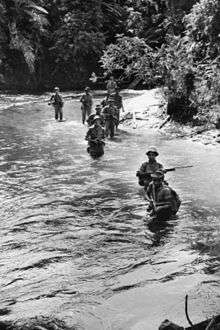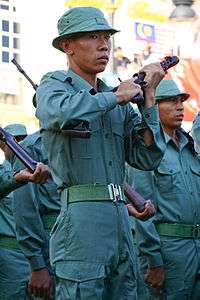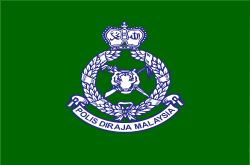General Operations Force
| General Operations Force | |
|---|---|
|
The RMP General Operations Force Emblem. | |
| Active |
|
| Country |
|
| Branch |
|
| Type | Light infantry |
| Role | Domestic Counter-insurgency, Multi-security service, VIPS Close Protection, Border Patrol and law enforcement |
| Size | 20,000 active personnels |
| Part of | Internal and Public Security |
| Garrison/HQ |
Bukit Aman Police Headquarters, Kuala Lumpur, and GOF Training Centre Ulu Kinta, Perak |
| Colour of Beret |
Dark blue beret - Standard paramilitary
|
| Anniversaries |
25 March (Police Day), 31 August (Independence Day) |
| Engagements |
|
The General Operations Force (Malay: Pasukan Gerakan Am; PGA) is the light infantry arm of the Royal Malaysia Police. The General Operations Force was established in 1948 during the Malayan Emergency by the British Administration when Malaya was a Colony. The Police service was mobilised to the field role, primarily to engaging Communist guerrillas during the emerging Insurgency. When Malaysia was formed in 1963, this law enforcement unit was then known as the Police Field Force. The title was adopted when it dropped the previous handle widely referred to as the Jungle Squad (Malay: Pasukan Polis Hutan, PPH).
History


The British Military Administration (BMA) had mobilised the police General Duties to assume the role of the military effort against the insurgencies. Jungle Squad was established in 1948 for the purpose against communist terrorists. Initially the new police arm was called the Flying Squad. However, it was renamed the "Jungle Squad" in the line with its major role against communist terrorists in the forest. In 1951, Jungle Squad restructured and became known as "Jungle Company". In 1953, the Jungle Company continued to be augmented and became known by the name Police Field Force (PPH). It is under the command of Police Commissioner of the Federation of Malaya and later Malaysia was established when the order was placed under the Chief of Police. The Jungle Company was then deployed together with the British Army to infiltrate and track down communist insurgents operating in the jungles of Malaya. The strength of a single platoon then consisted of a mixture of 15 personnel led by a Lance Corporal to an Inspector. Over the period covering the Malayan Emergency (1948–1960) the Police Field Force suffered over 1,000 casualties.
The Police Field Force was also involved during the Indonesia-Malaysia confrontations. In various actions during the Confrontation, the Police Field Force detained Indonesian Irregulars sent to the peninsula, with the view of running clandestine operations on Malaysian soil.[1] Following the May 13, 1969 incident was the Malaysian government will realise the importance of a team mobile and independent and more capable to the facing of public order situations.
Following the disarmament of the Malayan Communist Party (MCP) on 2 December 1989, the organisations of Police Field Force suffered to reformed with attenuation of 21 battalions to the 17 battalions on 1 September 1994. PPH changed its name to the General Operations Force (PGA) on 20 October 1997. On 11 November 1997, the submission of the RMP pennants ceremony officiated by the King of Malaysia. This change of name in accordance with the rating duties GOF background itself. Prior to this duties in GOF associated with the forest for combating the communist threats. After communist disarmed on 2 December 1989, GOF task has changed in the scenario is more varied.
Next on 1 July 2004, 19th Battalions was established officially in addition to the existing GOF battalion. It serves to provide security to dignitaries, buildings and a residence involving 89 VVIP locations around the Klang Valley. Their focus on efforts to protect the security of borders and territorial waters of invasion threats and illegal immigrants, robbery and smuggling at sea, carry out tasks to help maintain the public order and preventing the crime.
Chronology and incidents
On 3 June 1976, 35 recruits from Police Field Force members has been ambushed by the communist bandits at Bukit Keramat Pulai, Perak. During the incident at 12:45pm, Cpl 31507 who was a platoon leader as well as drill instructor was fatally shot in his side of eye. Four trainers TPC 63897, TPC 63899 and TPC 64010 were also killed about 15 metres from the communist control post. However, TPC 60899 Mohamad Salim and his teammates returned enemy fire. Shortly, this platoon successfully captured the communist stronghold which was modified to look like a house after the communist retreated after receiving violent opposition from the trainees. On extraordinary courage, TPC 60899 and TPC Mohammad Noh Hashim was awarded Panglima Gagah Berani one year later.[2][3]
Training
The first Training Centre was based at Sik, Kedah in 1949. Successful candidates trained there were sent on to the Police Field Force. Another School for the Police Field Force was opened in Sungai Buluh, Selangor with the aim of conducting basic training and refresher courses. In 1953, one new training centre was established in Dusun Tua, Hulu Langat, Selangor renamed the Jungle Squad Training Centre (Malay: Sekolah Latihan Pasukan Polis Hutan; SLPPH). In year 1964, the SLPPH was transferred to Kroh, Perak following the closure of the first two centres. The training centre itself was transferred again to Kentonmen, Ulu Kinta, Perak. The current title is the Pasukan Gerakan Am (General Operations Force), or the Sekolah Latihan Pasukan Gerakan Am, SLPGA (English: General Operations Forces Training Centre).
Weaponry
The firearms used by GOF during the year 1948 - 1980s.
| Firearms Data | |||||||
|---|---|---|---|---|---|---|---|
| Pistols/Revolvers | Shotguns | Submachineguns | Rifles | Machineguns | Grenades | Mortars | |
| Browning HP | Winchester M1897 | Sten Mk.II | Heckler & Koch HK33 | Bren LMG | Mills bomb | British 2-inch mortar | |
| Colt M1911A1 | Sten Mk.V | Lee–Enfield Rifle No. 4 Mk.I | ML 3-inch Mortar | ||||
| Webley Revolver | Sterling L2A3 | Lee–Enfield Rifle No. 4 Mk.II | |||||
| S&W M&P | Lee–Enfield Rifle No. 4 Mk.III | ||||||
| Lee–Enfield No.5 Mk.I | |||||||
| FN FAL L1A1 SLR | |||||||
| M1 carbine | |||||||
| M1A1 Carbine | |||||||
| M2 Carbine | |||||||
The firearms used by GOF during the year 1980 - presents.
| Firearms Data | |||||||
|---|---|---|---|---|---|---|---|
| Pistols/Revolvers | Shotguns | Submachineguns | Assault Rifles | Sniper Rifles | Machineguns | Grenades | |
| Beretta M92F | Remington M870 | HK MP5A2 | Colt M16A1 | HK G3/SG-1 | FN MAG | HK 69 | |
| Browning HP Mk.III | Remington M1100 | HK MP5A3 | Colt M16A2 | HK 11 LMG | M79 Grenade Launcher | ||
| Glock 19 | M203 | ||||||
| HK P9S | M67 grenade | ||||||
| S&W .38 2-inch Rev. | High Explosive Grenade | ||||||
| S&W .38 3-inch Rev. | Tear Gas Grenade | ||||||
| S&W .38 4-inch Rev. | |||||||
| SIG Sauer P226 | |||||||
| SIG Sauer P228 | |||||||
| Steyr M-9 | |||||||
| Vektor SP1 | |||||||
| Walther P99 | |||||||
| Yavuz 16 Compact | |||||||
Area of responsibility
| Battalion | Specialist | Headquarters |
|---|---|---|
| GOF 1st Battalion | Ulu Kinta, Perak | |
| GOF 2nd Battalion | Kulim, Kedah | |
| GOF 3rd Battalion | Bidor, Perak | |
| GOF 4th Battalion | Semenyih, Selangor | |
| GOF 5th Battalion | Simpang Renggam, Johor | |
| GOF 6th Battalion | Bakri, Muar, Johor | |
| GOF 7th Battalion | Kuantan, Pahang | |
| GOF 8th Battalion | Pengkalan Chepa, Kelantan | |
| GOF 9th Battalion | Kubang Badak, Terengganu | |
| GOF 10th Battalion | Sibu, Sarawak | |
| GOF 11th Battalion | Kuching, Sarawak | |
| GOF 12th Battalion | Miri, Sarawak | |
| GOF 14th Battalion | Tawau, Sabah | |
| GOF 15th Battalion | Sandakan, Sabah | |
| GOF 16th Battalion | Kota Kinabalu, Sabah | |
| GOF 17th Battalion | Lahad Datu, Sabah | |
| GOF 18th Battalion Senoi Praaq | Trackers | Pengkalan Hulu, Perak |
| GOF 19th Battalion | Area Security of VVIP | Cheras, Kuala Lumpur |
| GOF 20th Battalion | Beluran, Sabah | |
| Tiger Platoon | Sub special force | East Malaysia |
GOF functions
The General Operations Force are deployed, equipped and trained for specified roles in times of peace and during emergencies. The various roles include neutralising armed criminals, border patrols, counter terrorism, anti piracy and maritime security. The GOF also assists in general duties such as public security, close quarters combat in urban settings and anti smuggling patrols. In times of conflict or emergency, GOF brigades are used primarily for assigned duties in counter-terrorism and anti - guerrilla warfare. A brigade is essentially trained, equipped and organised for paramilitary roles in the field and also for insertion in major urban conurbations. All personnel are drawn from mainline Police Training Schools and inducted to GOF Training Centres, with the view of completing the study of anti guerrilla warfare and military training courses before graduating to GOF Battalions. Where borders are perilously dangerous, GOF units are deployed in localised security sweeps and defence operations. The GOF also employs units in riots and disturbances where necessary.
Organisations

The Royal Malaysia Police General Operations Force is organised along military lines consisting of Brigades, Battalions, Companies, Platoons and Sections deployed where needed.
GOF Brigades
There are currently five brigades located in both Peninsular Malaysia and East Malaysia and every Brigade is headed by those ranked Senior Assistant Commissioner II (SAC II) or above. The Northern Brigade based in Sabah, Borneo is composed of four battalions. There are a total of 11 Battalions split into three Brigades in peninsular Malaysia, and three battalions based in Sarawak. Every Brigade in the General Operations Force possesses one lightly armoured squadron.
GOF Battalions
GOF has a strength of 20 battalions located in both Peninsular Malaysia and East Malaysia with each commanded by a Police Superintendent. Each battalion consists of about three infantry companies and one mortar platoon.
Senoi Praaq
The Senoi Praaq means War People in the language of the Semai Indigenous people of Peninsula Malaysia. The formation was moved to the Police Field Force in 1968 and increased to two battalions. The Senoi Praaq were established in 1957 employed with tracking and security roles, apart from performing the main function of contact to the aborigines peoples. Manned by the aborigines of Peninsular Malaysia that were skilled for their jungle tracking, it was successful in engaging the communist terrorists during the Malayan Emergency. The Senooi Praaq can be distinguished from other mainline GOF Battalions by the use of the distinctive maroon beret and red hackle.
Tiger Platoon
Apart from the separate 69 Commando in Pasukan Gerakan Khas, the GOF established new units to operate in all mainline Battalions. These platoons were formed for special assignments, covert and overt operations and Search And Rescue, and are known generally as the Tiger Platoons.
Tasked in the year
The Police GOF was successful in dealing with the armed rebellion led by the communist terrorists in Malaysia. Today the roles of the General Operations Force includes border and maritime security, anti piracy patrols, counter-terrorism, public security, search and rescue (SAR) and organised crime. On 20 October 1997, the Police Field Force letterhead was changed to the new title; the General Operations Force or Pasukan Gerakan Am composed of 19 battalions organised in five brigades, deployed in both Peninsular Malaysia and East Malaysia. In June 2004, one specialised battalion was tasked for VVIP security. It is the GOF 19th Battalion, based in Cheras, Kuala Lumpur. In 2008, the GOF 20th Battalion was established and tasked specifically for airport special security in KLIA.
Operations
- 1948 – 1960 - During the Malayan Emergency, the Police Field Force were involved in security and offensive operations against communist insurgents.
- 1963 – 1966 - The service together with military forces to fight against the Indonesian soldiers during the Confrontation.[4]
- 1968 – 1989 - The Police Field Force deployed to track down the Communist Terrorists before the CPM accepted unconditional surrender in 1989.
- 1969 – The Police Field Force involved in security roles during the 13 May 1969 riots in Kuala Lumpur.
- 2001 – The General Operations Force supported the Pasukan Gerakan Khas anti-terror police to track downed Mat Komando, the crime leader of Gang 13 before he killed in shoot-out in the hut at Kampung Hujung Keton, Pendang, Kedah.
- 2007 – The Royal Malaysia Police deployed a force of 136 men from the Sarawak General Operations Force to Timor Leste. The force will join the United Nations Integrated Mission in Timor Leste, employed in the peace-keeping role.
- 2013 – Involved in 2013 Lahad Datu standoff. Deployed alongside Pasukan Gerakan Khas, Grup Gerak Khas, 10 Paratrooper Brigade, PASKAL, PASKAU, Unit Gempur Marin and Malaysian Maritime Enforcement Agency.
See also
References
- ↑ French 2011, p. 17.
- ↑ "Ambushed by communist - Four teammates down". Utusan Malaysia. 31 March 2005. Retrieved 25 March 2009.
- ↑ "Musa Hussain - Bitter event almost took the life". Utusan Malaysia. 1 May 2003. Retrieved 25 March 2009.
- ↑ NZ Malaya Veterans
External links
| Wikimedia Commons has media related to General Operations Force. |

